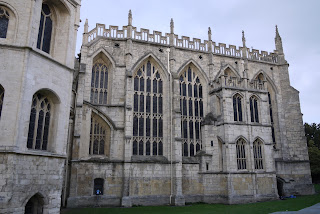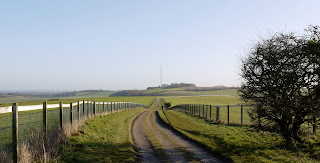The Cathedral
I have visited Gloucester quite often - my daughter lives there - but never really had a proper walk around the city. It dates back to Roman times, but much of the centre has a rather depressing 1960s sort of feel. Today it is time to have a closer look. I started to plan my route on the basis of a walk around Norman Gloucester that the BBC publicised around the time of a TV series on the Normans. Other influences were the City Council's City Centre map and a work meeting that led me to park at the end of Westgate.
It was mid-afternoon when I started then from the Westgate car park, and walked up Westgate St into the city. The four main streets are Westgate St, Eastgate St, Northgate St and Southgate St: sadly, the gates themselves are long gone. Immediately on the left is the redundant church of St Nicholas.
According to Pevsner, the church is of Norman, with all sorts of later additions and embellishments. The "conspicuous and pretty tower" dates from repair work of 1783.
Almost opposite is the half-timbered Bishop Hooper's Lodging of about 1500,which has been a folk museum since 1935. The house to the right early 17th century (Pevsner).
A bit further up Westgate St, past Shire Hall, I turned left into College St, with a handsome late Victorian Tudor-style block on the corner, and entered the Cathedral Close.
The Cathedral dates from about 1100 with a Norman nave with massive round columns. Much of the rest is Perpendicular Gothic of the 14th and 15th centuries. It was probably not the best day to visit the Cathedral as the south side is being renovated and so is covered with scaffold, and inside the whole of the nave was taken over for filming. Various figures in chain mail could be observed popping out for a cigarette or a cup of tea.
I managed to enter via the tea room and make my way into the spectacular cloisters. The East walk of the cloister has the earliest known fan-vaulting, dating from 1351-1377 according to Pevsner. The other three sides are slightly later.
It is quite spectacular, as impressive as some of the more celebrated examples such King's College chapel, which we visited recently.
The only other part of the interior I was able to see was the 15th century Lady Chapel. Below is a view from outside, inside you have the sensation of a wall of beautifully coloured glass, held in place by a remarkably small amount of stonework.
Just across the road, in a small grassy enclosure is the ruins of St Oswald's Priory. What you see is a row of Norman arches set in Saxon stonework. According to the BBC, they are the oldest remains which exist above ground in the city.
I swung right, past St Lucy's garden, to reach Northgate St, where I paused to look into the New Inn. I was amazed and delighted by the open gallery which runs all round the courtyard. Pevsner dates it to 1457 and comments "few inns in England can be so old and retain so much of their original character."
From here, I walked down to The Cross, where the four main streets intersect. There was a famous medieval High Cross here until 1751, when it was pulled down and replaced by a Tolsey House (where market tolls were collected), and in 1984 by a bank, also now demolished. Pevsner says that its current appearance "could hardly be more unworthy". Even the 15th century church of St Michael has only its tower still standing.
Further down Southgate St is the church of St Mary de Crypt, with the one-time St Mary de Crypt Grammar School (founded 1539, restored in the 19th century) to its left.
The church is again of Norman origin, but it now appears mainly Perpendicular, with Victorian restorations. Opposite is another lovely half-timbered house, 16th century, but recently restored. It was the home of Robert Raikes, the founder of the Sunday School Movement.
Next I turned right into Blackfriar St to reach Blackfriars Priory. Apparently, only two other Dominican friaries have survived in any degree of completeness (in Norwich and Newcastle).
After the dissolution of the monasteries, it was converted to be a private house and cloth factory, which no doubt explains why one's first impression is that it does not look like a monastery. It is now owned by English Heritage, whose website says that they are converting it into a venue for the performing arts. This is part of its continuing history and will give the building a new lease of life" (!)
Now it was a short walk to the docks, or rather the Historic Docks, most of which have been very nicely restored.
Finally, as I was heading back towards the Westgate car park I diverted to follow a sign to Llanthony Secunda Priory. This was especially interesting as we had seen the ruins of the parent Abbey at Llanthony in Wales last March. It was in the event rather disappointing. The ruined gatehouse was reasonably encouraging, but the only other remains were those of a stone tithe barn and the ruins of a timbered Tudor house.
more to see in the future.
I walked along the Quay, with the River Severn on my left, and just had time for one more surprise: the 18th century Customs House.
Conditions: cold, but bright
Distance: just under 3 miles
Rating: four stars. Really enjoyable and full of surprises. Gloucester hasn't conserved its heritage awfully well, but there are many delights. The Cathedral is a wonder.


















































